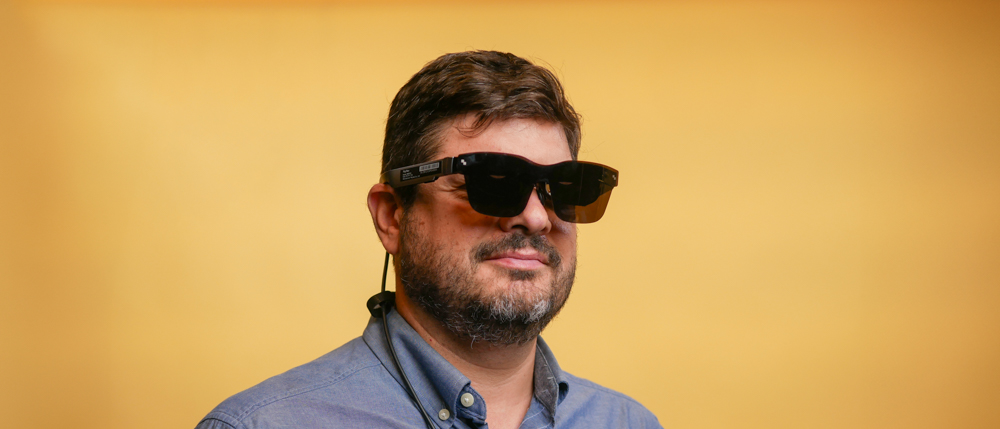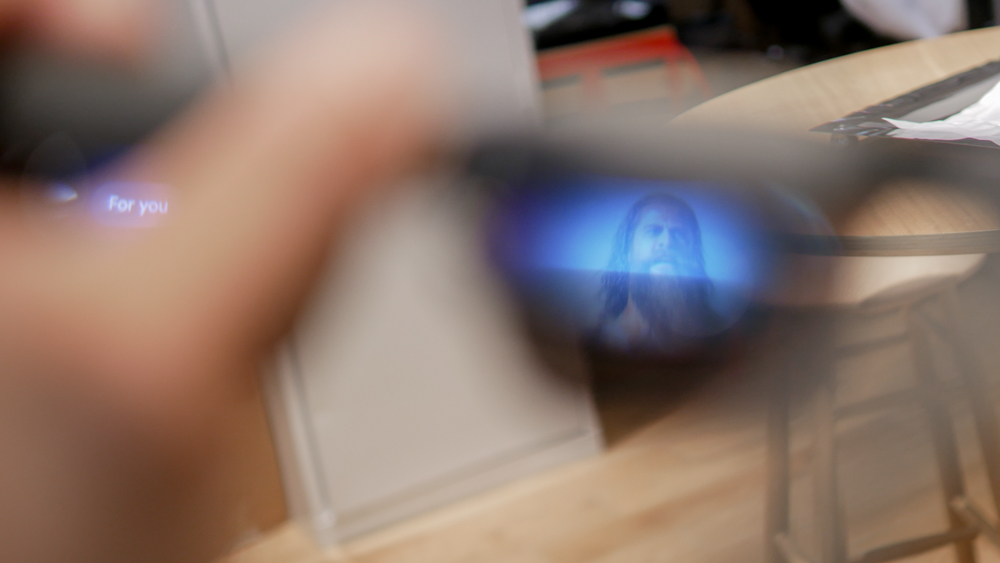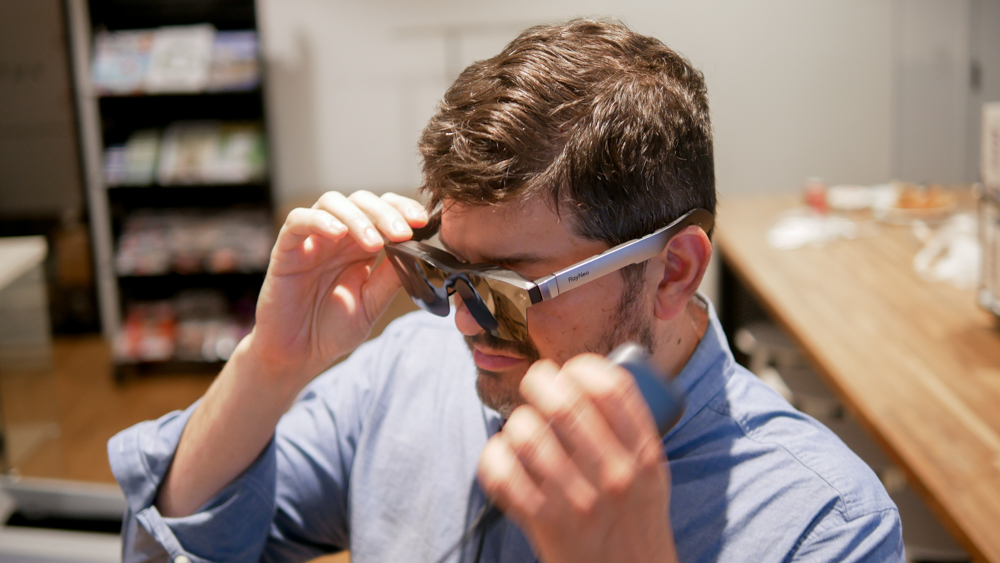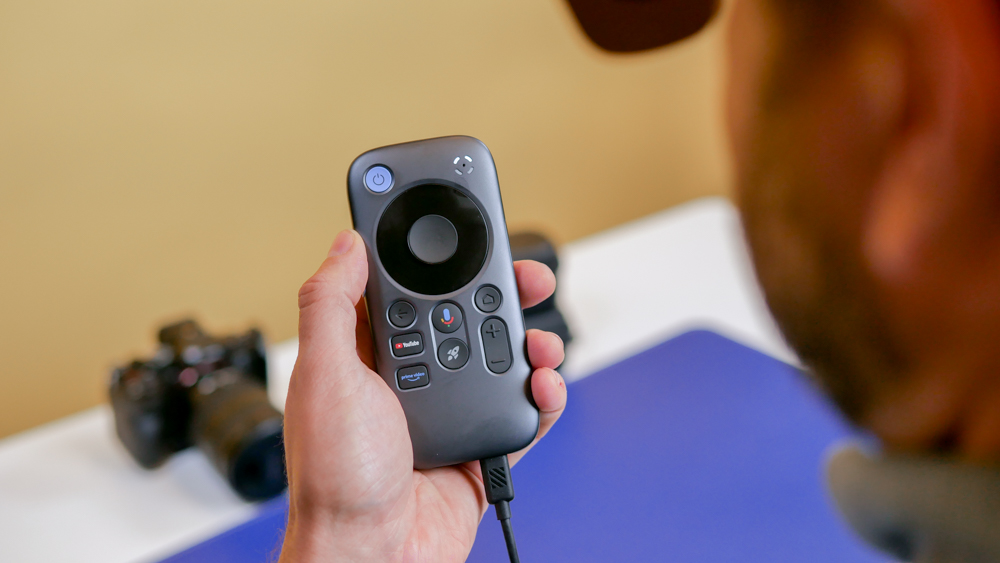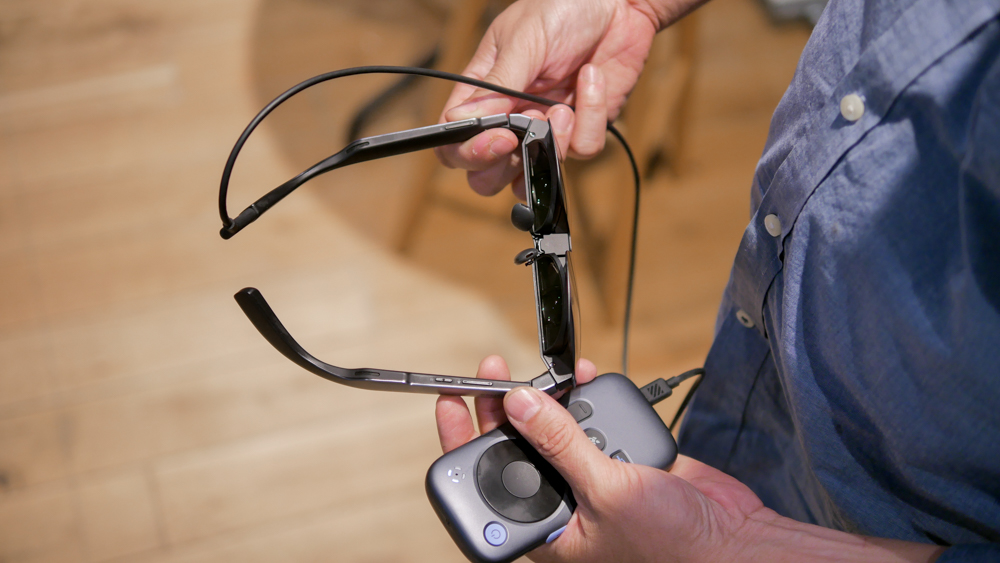Tom's Guide Verdict
The RayNeo Air 2S AR glasses and the Google-powered PocketTV puts a virtual theater in front of your eyes. It works great, but is hampered by the fact that it’s far less useful when not connected to Wi-Fi.
Pros
- +
Lets you stream videos from all major platforms
- +
Big, bright image
- +
Good audio
Cons
- -
Can’t save videos and shows from streaming apps for offline viewing
- -
PocketTV device gets hot to the touch
Why you can trust Tom's Guide
Resolution: 1920 x 1080 pixels per eye
Display: Micro OLED
Brightness: 600 nits
Refresh rate: 60/120Hz
Size: 6.9 x 6.07 x 1.86 inches
Weight: 2.8 ounces
Who doesn’t hate the small seatback screens on airplanes? Who wouldn’t want to tune out the rest of the world when you’re crammed into a tin can? The RayNeo Air 2S AR glasses and the RayNeo PocketTV aim to do just that.
The latter is a portable Google TV device that hooks up to the former, and lets you watch movies and TV shows from your favorite streaming service on a virtual, 200-inch screen. This focus on nailing the binge watching experience makes them the best AR glasses for picture and sound quality.
This bliss-in-a-pocket will set you back $500, the same as the Meta Quest 3, and while the RayNeo Air 2S isn’t as versatile as the best VR headset, it is more portable. But, there’s just one thing holding it back from being a truly great travel companion. You’ll have to read the rest of the RayNeo Air 2S review to find out though.
RayNeo Air 2S and Pocket TV: Price
The RayNeo Air 2S cost $399 at Amazon, and the RayNeo Pocket TV costs $179 individually, but the company sells them as a bundle for $499.
RayNeo sells a few other accessories for its glasses. If you want to use the glasses with your Nintendo Switch, you can get the glasses bundled with the JoyDock (a battery and adapter) for $439.
If all you want to do is use the glasses with your smartphone, I recommend the MiraScreen Portable Adapter ($99), which has a built-in battery that will provide up to 3.5 hours of battery life, so you don’t drain your phone.
RayNeo Air 2S review: Design
The Air 2S looks like a chunky pair of Wayfarer glasses. It’s more obvious that they’re techwear than the Meta Ray-Bans, but not as in-your-face as the Meta Quest 3 or Apple Vision Pro. Behind the front lenses you’ll find two micro OLED displays with a resolution of 1080p, and a virtual screen size of 201 inches.
Get instant access to breaking news, the hottest reviews, great deals and helpful tips.
They have a maximum brightness of 600 nits, an advertised contrast ratio of 100,000:1, and can display 108% of the sRGB gamut. The refresh rate can also be switched from 60 to 120Hz.
They weigh roughly 2.8 ounces, far less than the 1-pound VR headsets from Meta and Apple.
Buttons on both temples of the glasses let you control volume and access menus, and a USB-C port on the back of the right arm lets you connect it to a battery pack or accessory such as the PocketTV. Also embedded in each arm is a small speaker.
You can adjust the angle of the glasses by bending its arms so you’re either looking a little upward or a little downward at the screen; however, you have to use a bit of force, and each adjustment makes a loud POP!, which can be disconcerting. I also found that no matter how I adjusted the glasses, there was always one corner or side that was a bit fuzzy, but not enough to be distracting when I watched a movie. The glasses automatically shut off when you remove them from your head, a nice touch.
If you wear glasses, you can get a custom set of lenses made for the Air 2S at lensology.co.uk.
RayNeo PocketTV
The PocketTV looks like an Apple TV remote got stung by a bee. Its length and width are similar to a small smartphone, but it’s much chunkier, at around an inch thick. Its edges are all curved, which makes it very comfortable to hold. A large circular d-pad dominates the front, with a small assortment of buttons beneath: volume controls, a Home button, Back, a button to summon Google Assistant, quick-access buttons for YouTube and Prime Video, and one programmable key. I wish the buttons were backlit, but because you’re going to be using them while you’re wearing the glasses, knowing them by feel is more important.
As with any Google TV device, you can download any compatible app and install it on the Pocket TV, just as if you were sitting in your living room.
The bottom of the PocketTV has two USB-C ports, one to charge the device, and one to connect it to the RayNeo Air 2S glasses (or other compatible AR glasses. It also has a microSD card slot, and can take cards up to 2TB in size. Its internal 6,500mAh battery is good for up to 5.5 hours.
RayNeo Air 2S review: Performance
After using the RayNeo Air 2S, I may have to make them my traveling companion any time I take an airplane trip. I was thoroughly impressed with the quality of its OLED displays. While their 1080p resolution is not as high as the Meta 3 (2,064 x 2,208 pixels per eye), I found everything I watched to be very clear, crisp, and colorful. They were fairly comfortable to wear, too, though I did like taking breaks every half hour or so.
The nuclear explosion in “Oppenheimer” was bright and fiery, and when I watched “Blue Angels” on Prime Video, it almost felt as if I were strapped into the cockpit of the F/A-18. However, in both movies, I did notice a fair amount of color banding in scenes that transitioned from very dark to very light, and vice-versa.
The Air 2S’s speakers were also pretty good for their size. You’re not going to get the greatest bass, but if you’re watching a movie at home, they provide a nice experience. However, if you’re using these things in public, you’ll want to connect them to a pair of the best wireless earbuds — preferably, ones that don’t have ear loops.
The PocketTV device also worked well. It was easy to control just by feel, and it doesn’t take up too much space. However, I did have two issues with it. The first is that the back of the device got pretty toasty — 110 degrees Fahrenheit — to the point where I wouldn’t want to hold it for an extended period of time.
While I like that the PocketTV has expandable storage, there’s a catch: Because it runs Google TV apps, and not smartphone apps, there’s no option to download videos from, say, Disney Plus and watch them offline. You can sideload videos, but who wants to do that?
There is a workaround, but it requires you have a compatible smartphone with USB Type-C with DisplayPort (DP) output, such as the iPhone 15, Samsung Galaxy series, Oppo, OnePlus, and Huawei (a complete list can be found here), you can connect one of these phones directly to the headset. If your phone lacks that, you’ll need the RayNeo adapter ($99 on Amazon). I tried connecting the RayNeo glasses to a Google Pixel 8 phone, but it didn’t work.
Even if your phone does support the connection, the adapter could still be a wise investment, as it will provide power to the glasses, rather than draining your phone’s battery.
Because the PocketTV is a Google TV device, you can cast to it from other devices, such as your smartphone. I was able to cast “Star Wars: Tales of the Empire” from my iPhone to the PocketTV with no problems. However, if you’re on an airplane and can’t connect the PocketTV to Wi-Fi (along with your phone), you’re still going to be stuck in the same situation.
RayNeo Air 2S review: Verdict
The RayNeo Air 2S and the PocketTV are fun little devices, and would be a great combo for travel, if for one thing. Because you can’t easily download videos from popular streaming services to the PocketTV device, it’s pretty much useless if it’s not connected to Wi-Fi — which is often the case when you’re on an airplane, in a car, or traveling somewhere and want to tune out the world. If Google TV apps let you download content, this issue would take care of itself. Until that happens, the RayNeo Air 2S and PocketTV is a great headset with one little flaw.

Michael A. Prospero is the U.S. Editor-in-Chief for Tom’s Guide. He oversees all evergreen content and oversees the Homes, Smart Home, and Fitness/Wearables categories for the site. In his spare time, he also tests out the latest drones, electric scooters, and smart home gadgets, such as video doorbells. Before his tenure at Tom's Guide, he was the Reviews Editor for Laptop Magazine, a reporter at Fast Company, the Times of Trenton, and, many eons back, an intern at George magazine. He received his undergraduate degree from Boston College, where he worked on the campus newspaper The Heights, and then attended the Columbia University school of Journalism. When he’s not testing out the latest running watch, electric scooter, or skiing or training for a marathon, he’s probably using the latest sous vide machine, smoker, or pizza oven, to the delight — or chagrin — of his family.
